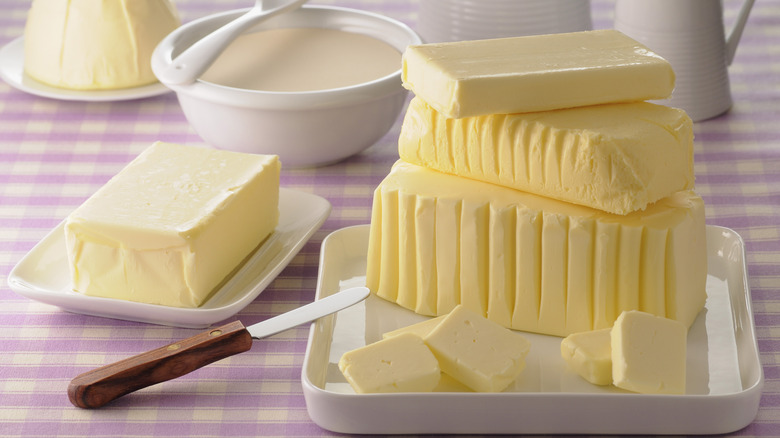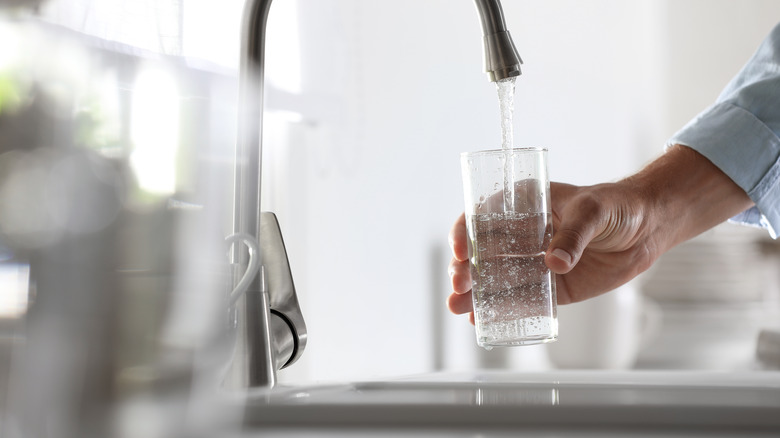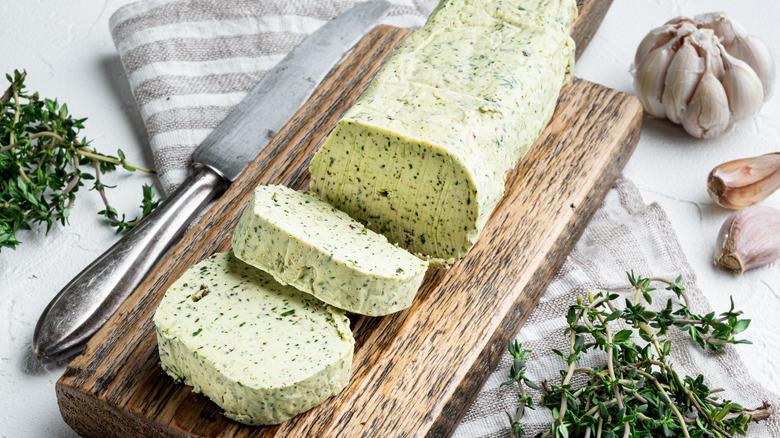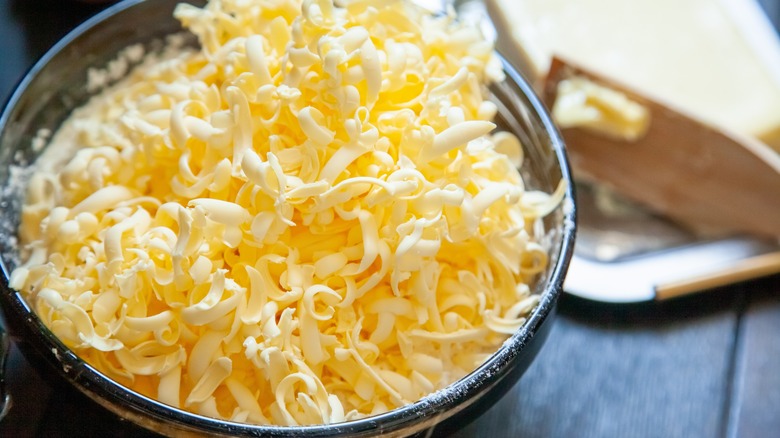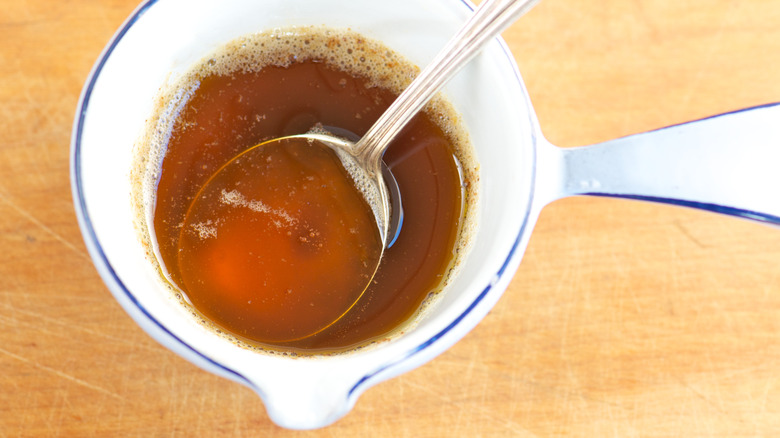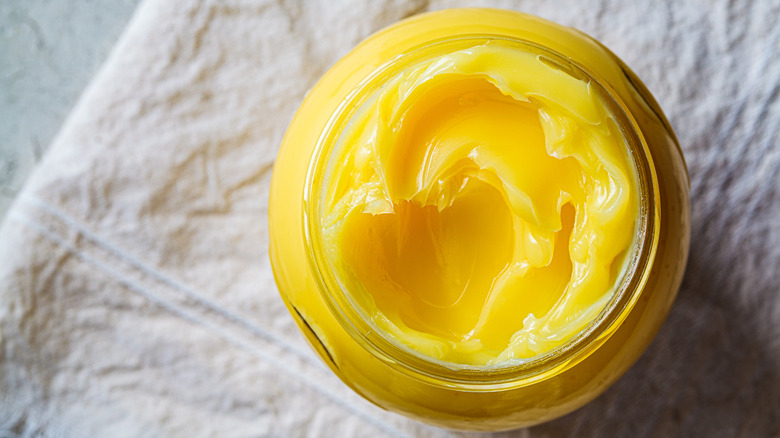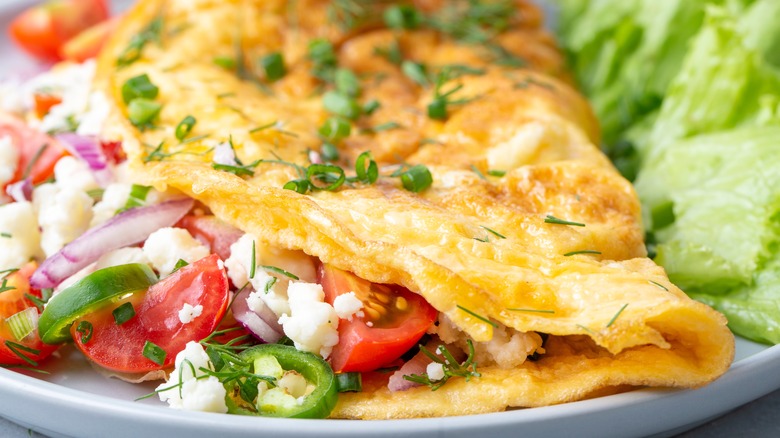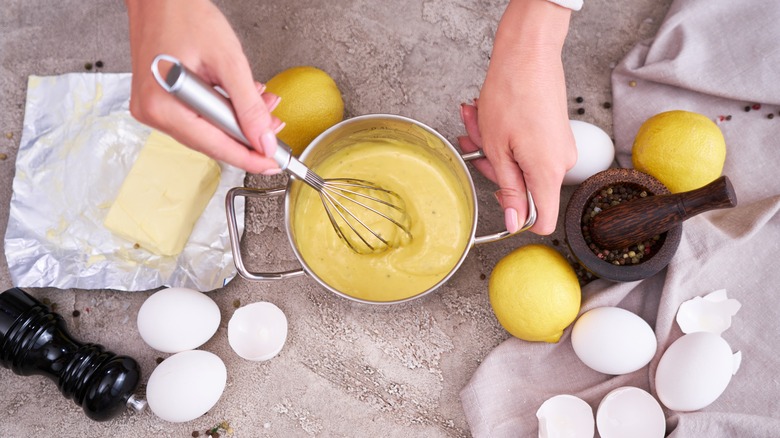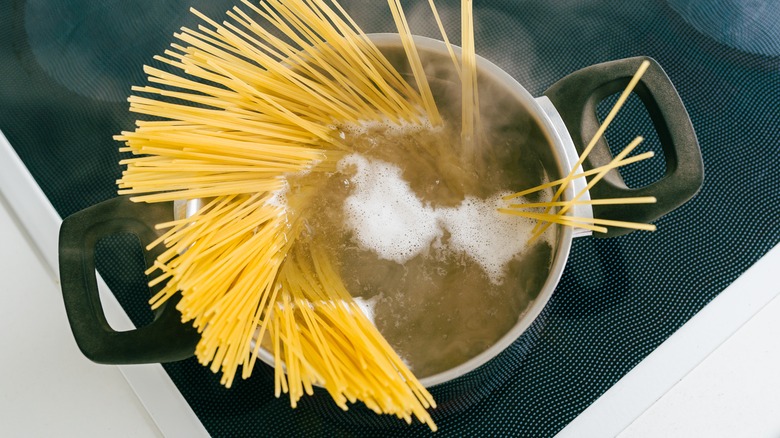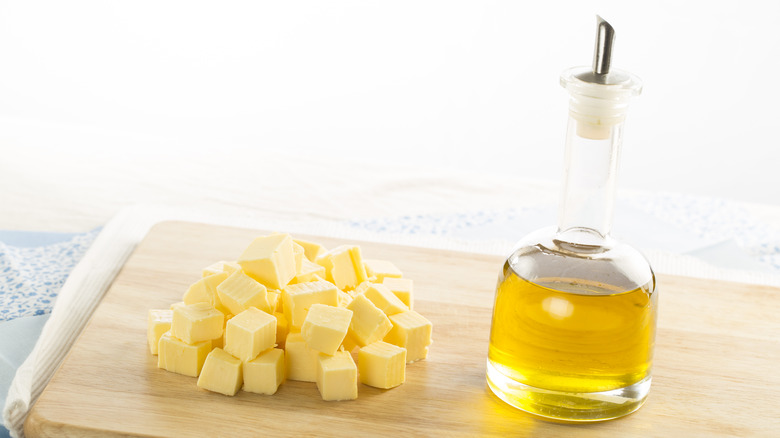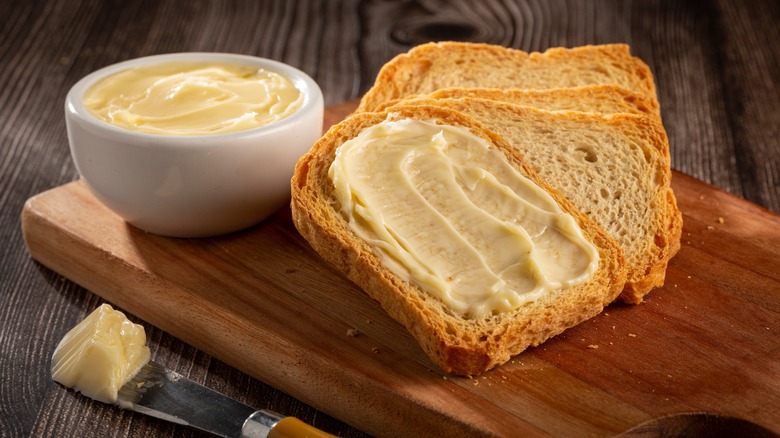10 Hacks That Will Transform The Way You Cook With Butter
For most home cooks, butter is a basic ingredient that's easy to take for granted. You might melt a little in a non-stick pan before you cook your eggs. You mix a stick with some sugar when making your favorite chocolate chip cookie recipe. You slather a little on a scone, biscuit, or piece of toast at the breakfast table. Butter is pretty simple, but a staple.
However, while you might not give the butter in your fridge (or in your butter dish) a second thought, you may be able to upgrade the way you cook with butter, for better results, whether you're making an omelet, pasta, a pastry crust, or anything in between. The right butter choices can make a big difference, so we're sharing some of our favorite hacks that will totally transform the way you cook with butter. Once you try a few, you may just never look at butter the same way again.
Soften your butter using a hot glass of water
You go to the kitchen to start mixing up some cookie dough or a cake. You start reading down your list of ingredients and recipe instructions and then recall that you totally forgot to do the one thing that comes first in so many baking recipes. You didn't allow the butter to come to room temperature.
If you're one of those home cooks who leaves their butter in a dish at room temperature all the time anyway, then this isn't a big deal for you. However, if you keep your butter in the fridge, this baking misstep can mean disaster. Use the butter cold and whatever you're baking just isn't going to turn out right. The same goes for if you toss the butter into the microwave to "soften" it (aka, half-soften, half-melt it, because the microwave is never going to just bring your butter to room temp). Baking is a science, so having ingredients at the right temperature matters.
Well, with this hack, cold butter is a worry of the past. As shared on TikTok by user margaritav24, the hack is simple. Just fill a glass with hot water. Let the glass get hot, then, empty the water out. Set your (wrapped) butter on a dish and cover it with the upside-down glass. Wait a few minutes and give the butter a squeeze. It should feel just like room temp butter that's been sitting out for hours.
Make your own flavored butter
Forget that Plain Jane butter that you've been eating on your toast or serving alongside your charcuterie board bread. If you love the various flavored butters you can usually find at restaurants, it's time to start making your own flavored butter at home using just two simple steps. Just blend and add. That's literally it.
All you have to do is blend your softened butter with your electric mixer until it's smooth, light, and airy, and then add in your preferred flavors. You're only limited by your own creativity. Savory possibilities include herbs, spices, garlic, red wine, or shallots. Spicy options include jalapeños, horseradish, or Sriracha. Sweet, flavored butter options start with honey, brown sugar, vanilla, cinnamon, or maple syrup. If adding a chopped or diced ingredient, your butter may come out a little chunky, but that's okay. Keep it soft and it'll still be spreadable. If you need to store your leftover butter after you make it, just pop it in the fridge and then, when you want to use it again, let it soften up and give it another mix.
Grate butter while it's extra cold
While a lot of baking recipes may call for room-temperature butter, pastry recipes, as well as recipes for scones and biscuits, call for cold butter. This is for the same reason that other recipes call for room-temperature butter: science. The cold butter results in a light, flaky texture that you just can't accomplish otherwise.
When making many of these cold-butter recipes, you'll be told to cut in the butter. However, cutting butter into any recipe can be laborious and tricky (how big, exactly, do these chunks of butter need to be?), which is why many choose to grate their butter into their dry ingredients instead. When you grate your butter, you avoid ending up with too-large chunks of butter in your dough, as the consistency is the same throughout and the grated butter mixes very easily with dry ingredients.
Grating butter isn't without its problems, though. Grate even just a slightly warm stick of butter and you may just find yourself in danger of losing a few fingers. Save those digits by popping your butter into the freezer before you grate, so the butter becomes rock-hard and less likely to slip and slide all over the place.
In addition to grating butter for pastries and other baking recipes, you might find grating a preferable option for avoiding lumps as you make frostings, too.
Brown butter for extra flavor
Brown butter offers a distinctive, nutty flavor that, once you try, you won't be able to forget. You can easily upgrade sauces, eggs, and even baked goods by browning your butter before you add it to your recipe. It's a quick and easy hack that requires no extra ingredients and very little time.
If you've never browned butter before, all you need to do is dice your butter and add it to a saucepan over high heat. Let the butter melt down and start to bubble and foam. Keep the melted butter moving so that it doesn't burn. If you see some brown bits forming, don't worry. That's not burning. That's the fat in the butter separating and cooking. Once you see those brown bits, take your butter off the heat. This deep gold liquid is ready for adding to a range of dishes, like this butternut squash pasta with brown butter, or any recipe that also uses vanilla, as vanilla and brown butter amplify one another's flavors.
Make ghee for high-temp cooking and your lactose-intolerant friends
Ghee is an ancient ingredient that's traditionally associated with Indian cuisine, but it's been gaining traction in the mainstream in more recent history. Essentially just clarified butter, ghee is made by heating butter on low heat until it browns, much like you would do when making brown butter. However, while, at this point, your brown butter would be finished, there are still a few more steps to go before you end up with ghee. After cooking, the butter has to be strained, which removes all the brown bits of milk solids. The resulting liquid is then left at room temperature, solidifying. The end result is ghee.
Compared to brown butter, ghee offers a similar flavor, but the removal of the milk solids makes for a cooking fat with some extra benefits. For one, ghee boasts an impressively high smoke point, at 450 degrees Fahrenheit, which places it higher than coconut oil, canola oil, sunflower oil, grapeseed oil, olive oil, and others. Secondly, ghee, despite being made from butter and butter alone, is typically tolerated by those with lactose intolerance, according to Cleveland Clinic, due to its low lactose and casein levels.
Prevent rubbery omelets with butter
If you're making an omelet (or any form of eggs that you might make in a sauté pan, for that matter), you could feasibly add any fat or oil to the pan before your eggs, if all you're trying to achieve is reducing the amount of egg that ends up stuck to the bottom of your cookware. However, if you want the best omelet possible, there are some scientific reasons why you might want to choose butter for your omelet — and not just in the pan.
If you add cubed butter to your whisked eggs before you start cooking your omelet, the result will be less of that rubbery texture that's all too common in omelets. Why is this? Well, the cooking process changes the chemical makeup of egg whites, making them rubbery. The butter prevents this chemical change from occurring. The egg whites remain soft, not rubbery, giving you a delectable omelet.
Add cold butter to pan sauces to keep them from breaking
If you've ever made an emulsified sauce before — like hollandaise — and the sauce accidentally "broke," your heart may have broken as well. When a sauce breaks, the emulsification process is basically undone. The fats and liquids separate, leaving you with a sauce that's neither pretty nor tasty.
However, you can prevent a broken pan sauce by using cold, cubed butter rather than room temperature or warm butter in your sauce recipes and, as is the case with so many of our butter hacks, it's all because of science. When your butter is at a colder temperature when you add it to the pan, it melts more slowly in your sauce and the fat, which is suspended in the liquid as the emulsification process occurs, is suspended in smaller portions. Both of these factors make for a more stable sauce and a more stable sauce is one that will be less prone to breaking. So, the next time you make a pan sauce that includes butter, be sure to add your butter cold and slow.
Add butter to your pasta water to keep it from boiling over
There are few things quite as annoying as your pasta water boiling over when you're just trying to cook your pasta, a process that should be pretty easy. Things are boiling along nicely and then you turn your back for a second too long and then chaos occurs, with bubbling water spilling out all over your stove and causing a huge mess. And it's always pasta that causes this problem, too — nothing else. What gives and how can you fix it?
While adding butter or oil of any kind to pasta is a bit of a hotly debated topic, Purdue University professor of biochemistry Roy Whistler told The Chicago Tribune that a little bit of butter can go a long way to ensuring your pasta water doesn't boil over the side of the pot. He explained that, during the cooking process, the pasta emits starch into the water. The starch rises to the top of the water and blocks steam. The water beneath expands as a result, pushing upward and over. If you add a bit of butter to the pot, though, the fat molecules prevent the starch from creating that block and evaporation can continue, just like it might when you're boiling anything else.
Mix butter and oil for a higher smoking point and more flavor
Wondering if you should cook something with butter or oil? Why not go with both? In some instances, it makes sense to combine the two in order to reap the benefits of both while likewise negating some of the downsides of both.
You likely know that if you cook with just oil alone, you're not adding much flavor to whatever it is you're cooking. On the flip side, if you cook with butter alone, you'll get the great flavor of butter, but cooking with butter isn't always ideal due to its low smoke point. If you want the flavor of butter and the high smoking point of oil, then, the next time you sauté something in oil, add a little butter to the mix. You'll get the flavor you want, but since you're not cooking exclusively in butter, you won't need to worry about it all burning. The butter will burn off at some point, but you won't be able to taste it in the same in-your-face way that you might when cooking with butter only.
Butter your bread before toasting
Everyone knows that butter and toast go together. However, most would agree that you're supposed to butter the toast after it's, well, toast — but what if you could upgrade your toast by buttering it before toasting?
If you butter your bread before toasting, you'll find that the resulting toast isn't dry and the butter isn't lukewarm (or, as is usually the case, cold). Instead, this new take on toast is moist and buttery on the inside, all the way through, plus crispy on the top, and the butter is just as warm as the toast itself. You'll never go back to scraping cold butter on dry, crumbly toast again.
The only thing you have to make sure you do for this hack? Don't butter your bread and then toast it in a regular toaster. You have to use a toaster oven or regular oven that allows you to toast your bread horizontally.
